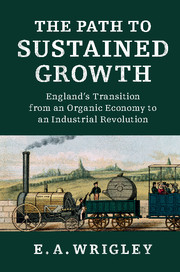 The Path to Sustained Growth
The Path to Sustained Growth Book contents
- Frontmatter
- Dedication
- Contents
- List of figures
- List of tables
- Acknowledgements
- Introduction
- 1 Organic economies
- 2 The classical economists
- 3 Energy consumption
- 4 Urban growth and agricultural productivity
- 5 Changing occupational structure and consumer demand
- 6 Demography and the economy
- 7 Transport
- 8 England in 1831
- 9 The completion of the industrial revolution
- 10 Review and reflection
- Bibliography
- Index
7 - Transport
Published online by Cambridge University Press: 05 January 2016
- Frontmatter
- Dedication
- Contents
- List of figures
- List of tables
- Acknowledgements
- Introduction
- 1 Organic economies
- 2 The classical economists
- 3 Energy consumption
- 4 Urban growth and agricultural productivity
- 5 Changing occupational structure and consumer demand
- 6 Demography and the economy
- 7 Transport
- 8 England in 1831
- 9 The completion of the industrial revolution
- 10 Review and reflection
- Bibliography
- Index
Summary
Von Thünen's The isolated state provides a telling analysis of the constraints imposed by transport costs on economic activity in an organic economy. Von Thünen had personal experience of these constraints since as a young man he bought the estate of Tellow in Mecklenburg. He describes, for example, the transfer of a load of grain weighing 2,400 pounds by a wagon drawn by four horses from the estate to the town of Rostock, a distance of 23 miles. In hauling the wagon to Rostock the horses consumed 150 pounds of grain so that only 2,250 pounds of grain was delivered. The energy needed to transfer the product reduced its value by 6 per cent, illustrating the way in which the energy consumed in effecting a transfer gradually reduced the net value of the goods delivered. The heavier and bulkier the product, the more severely the accessible market area was limited.
One of the central issues examined in The isolated state is the way in which transport cost strongly influenced land use in an area surrounding a town. In approaching this topic, von Thünen was influenced by his reading of The wealth of nations. Adam Smith stressed the significance of transport costs in relation to the size of an accessible market. In an assessment of the importance of good transport facilities, he asserted that: ‘Good roads, canals, and navigable rivers, by diminishing the expence of carriage, put the remote parts of the country more nearly upon a level with those in the neighbourhood of the town. They are upon that account the greatest of all improvements. They encourage the cultivation of the remote, which must always be the most extensive circle of the country.’ Von Thünen's book is an examination of the characteristic pattern of land use in the countryside surrounding a market town in an organic economy. To simplify his exposition he assumed that the surrounding countryside was a uniform flat plain. In these circumstances, the type of crop that will be found in any given area will be a function of its value to weight ratio and its distance from the town. Jointly, these two factors will give rise to a series of concentric bands of land use providing the food and fuel needs of the town.
- Type
- Chapter
- Information
- The Path to Sustained GrowthEngland's Transition from an Organic Economy to an Industrial Revolution, pp. 132 - 150Publisher: Cambridge University PressPrint publication year: 2016


